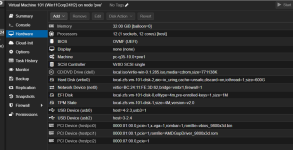Proxmox 9.0 + AMD Radeon iGPU (Granite Ridge) Passthrough: A Desperate Plea for Help
Hardware:- Host: Minisforum MS-A2 (Ryzen 7 9800X3D, Granite Ridge iGPU 1002:13c0)
- VM: Windows 11 Pro (24H2)
- Proxmox Version: 9.0 (Kernel 6.14.11-2-pve)
The Problem: "Loading Initial ramdisk" Hang with Error 43
After weeks of relentless effort, I am stuck at the most frustrating point in GPU passthrough: the VM starts (TASK OK), but then hangs indefinitely at the "Loading Initial ramdisk" screen on the physical monitor connected to my MS-A2's GPU output. The Proxmox web console shows a black screen.I have exhausted every known solution, and I'm now reaching out for help from the community.
What I've Tried (Systematically)
I have followed every guide, forum post, and GitHub thread I could find. Here is a detailed account of my journey:- Initial Setup & Kernel Selection
- I started with the default Proxmox kernel (6.14.11-2-pve).
- This kernel is the latest stable version for Proxmox 9.0.
- I confirmed that the Ubuntu Live CD boots perfectly on the passed-through GPU, proving hardware compatibility.
- Addressing the AMD Reset Bug with vendor-reset
- The error writing '1' to '/sys/bus/pci/devices/0000:01:00.0/reset': Inappropriate ioctl for device message is expected and is the manifestation of the AMD reset bug.
- To fix this, I used the ballerburg9005/vendor-reset fork, which includes patches for newer kernels.
- I manually edited src/device-db.h to add {PCI_VENDOR_ID_ATI, 0x13c0, op, DEVICE_INFO(AMD_NAVI10)}, /* Granite Ridge iGPU */.
- I fixed a compilation error by changing #include <asm/unaligned.h> to #include <linux/unaligned.h> in src/amd/amdgpu/atom.c.
- The module compiled successfully and is loaded at boot (lsmod | grep vendor_reset confirms it).
3.Ensuring GPU Isolation with VFIO
- I configured /etc/modprobe.d/vfio.conf:
options vfio-pci ids=1002:13c0,1002:1640 disable_vga=1
I blacklisted host drivers in /etc/modprobe.d/blacklist.conf:
blacklist amdgpu
blacklist radeon
blacklist snd_hda_intel
- After rebooting, lspci -nnk -s 01:00.0 correctly shows Kernel driver in use: vfio-pci.
- 4.VM Configuration with Hypervisor Hiding
- My VM config (/etc/pve/qemu-server/101.conf) includes:
machine: pc-q35-10.0+pve1
vga: none
# GPU Passthrough
hostpci0: 0000:01:00.0,pcie=1,primary-gpu=1,rombar=1
hostpci1: 0000:01:00.1,pcie=1,rombar=0
args: -cpu 'host,kvm=off,hv_vendor_id=proxmox,hv_relaxed,hv_spinlocks=0x1fff,hv_vapic,hv_time'
- I have installed VirtIO drivers from the ISO.
- 5. The Clean Install Method (The "Only Way")
- As advised, I performed a clean install of Windows 11 without GPU passthrough first.
- I then added the GPU passthrough after a full installation and shutdown.
- Despite this, the VM still hangs at "Loading Initial ramdisk".
- Testing Alternative Kernels
- I attempted to switch to an older, more stable Proxmox kernel (6.8.12-11-pve), as recommended in several guides.
- However, even on this kernel, the issue persists. The vendor-reset module loads, the GPU is isolated, but the VM still hangs.
- The SeaBIOS Fallback
- As a last resort, I tried switching to bios: seabios and machine: pc-i440fx-9.0.
- This bypasses UEFI entirely and forces a legacy VGA handshake.
- Unfortunately, this did not resolve the hang.
The Current State
- Host Side:
 Perfect. All configurations are correct. vendor-reset is loaded, GPU is isolated via vfio-pci, and the kernel is stable.
Perfect. All configurations are correct. vendor-reset is loaded, GPU is isolated via vfio-pci, and the kernel is stable. - Guest Side:
 Failed. The VM fails to initialize the GPU correctly during early boot, leading to the "Loading Initial ramdisk" hang.
Failed. The VM fails to initialize the GPU correctly during early boot, leading to the "Loading Initial ramdisk" hang.
My Theory
This is not a configuration error. It is a UEFI GOP (Graphics Output Protocol) incompatibility between my specific Granite Ridge iGPU and QEMU/OVMF. Ubuntu works because Linux is more forgiving about early graphics initialization. Windows is not.The vendor-reset module handles the reset bug, but it does not solve the fundamental issue of Windows failing to initialize the GPU's UEFI firmware.
Request for Help
I have done everything possible within my knowledge. I need help from the community.Please, can anyone who has successfully passed through a Granite Ridge iGPU (or similar AMD iGPU) on Proxmox 9.0 with a recent kernel share their exact configuration?
Specifically, I need to know:
- What args line they use in their VM config?
- Did they use vendor-reset? If so, what kernel version and patch were used?
- Did they use seabios or stick with ovmf?
- Are there any specific BIOS settings on the MS-A2 that are critical?
Any insight, suggestion, or alternative approach would be immensely appreciated. I am ready to try anything.
Links to Relevant Resources:
- Forum Post: Working AMD RX 9070XT Support
- GitHub: ballerburg9005/vendor-reset
- Forum Post: Solved - Proxmox 8.3.5 Kernel 6.11.11-1 Unable to Pass Through AMD iGPU
- GitHub: gnif/vendor-reset
Thank you in advance for your time and expertise.


